#uctv
Explore tagged Tumblr posts
Text
youtube
UCTV Big East Media Day coverage
46 notes
·
View notes
Text
One last game day post guys please repost on your stories also I don’t wanna sound idk what but like I also don’t know when but when I go back on that uctv page they lowkey seem like they started copying the type of posts I made I know Friday beers is also known to do it and it’s their thing so but idk anyways szn is already over my page has its own flare I love how many people it brought me close with and how much I learned and love this game I hope to still post but just know this is just the start game day posts will still happen next szn but for now like the ones I already have up and repost also make sure to follow the insta 💗💗💗💗💗 I love you all

#paige bueckers#uconn wbb#uconn huskies#azzi fudd#ncaa wbb#paige x azzi#basketball#kk arnold#wnba#caitlin clark#Instagram
13 notes
·
View notes
Text
"Obviously, l'd rather (return) sooner rather than later, but I think we're kind of just taking it step by step, like each progression, making sure that I'm feeling good at where l am right now in practice, and as I'm adding more, making sure, like, my knee responds well," Fudd said before adding, "I've never been so happy to practice in my life."
my brain is so powerful i might go back to school and become a PT
also, this is why I said I wanted the videos to come out because UCTV didn’t have this whole spill in their tweets. All they had was the last sentence. 
8 notes
·
View notes
Text
“The most common way people give up their power is by thinking they don’t have any.”
“No person is your friend who demands your silence, or denies your right to grow.”
“Hard times require furious dancing. Each of us is proof.”
- Alice Walker
Video Credit: University of California Television (UCTV) on YT
Source: @femalepoetssociety for more content of incredible female poets.
1 note
·
View note
Text

Sure enjoyed our impromptu pickin’ session with my guest Dawson Wright on Appalachian Sounds this evening on UCTV !
Talented Share America Foundation, Inc. Scholar and great member of the Hollywood Hillbilly Jamboree.
www.RandallFranks.com/store
#Appalachia #Bluegrass
1 note
·
View note
Video
youtube
Esperando el Mundial (España 1982) / Canal 13 UCTV Chile - Junio 1982
0 notes
Text
youtube
My Brain Made Me Buy It: The Neuroethics of Advertising - Exploring Ethics
"The consumer neuroscience industry is entering its second decade and continuing to grow thanks to increased acceptance by advertisers looking to better understand consumers' preferences and decision making. However, more questions and concerns are being raised as advertising techniques challenge social and ethical boundaries. Dr. Carl Marci, Chief Neuroscientist at Nielsen, will address the ethical concerns related to consumer neuroscience including issues around privacy, informed consent, and consumer autonomy in decision making. "
Source: University of California Television (UCTV)
#mktmarketing4you #corporatestrategy #marketing #M4Y #lovemarketing #IPAM #ipammarketingschool #ContingencyPlanning #virtual #volunteering #project #Management #Economy #ConsumptionBehavior #BrandManagement #ProductManagement #Logistics #Lifecycle #Brand #Neuromarketing #McKinseyMatrix #Viralmarketing #Facebook #Marketingmetrics #icebergmodel #EdgarScheinsCultureModel #GuerrillaMarketing #STARMethod #7SFramework #gapanalysis #AIDAModel #SixLeadershipStyles #MintoPyramidPrinciple #StrategyDiamond #InternalRateofReturn #irr #BrandManagement #dripmodel #HoshinPlanning #XMatrix #backtobasics #BalancedScorecard #Product #ProductManagement #Logistics #Branding #freemium #businessmodel #business #4P #3C #BCG #SWOT #TOWS #EisenhowerMatrix #Study #marketingresearch #marketer #marketing manager #Painpoints #Pestel #ValueChain # VRIO #marketingmix #universitycalifornia
Thank you for following All about Marketing 4 You
1 note
·
View note
Text
CHANNELETTES SKETCH DUMP
Context: This is for my idea of Channelettes, which are Antropomorphised TV Channels. Or TV Channels Gijinka.
I love Gijinka ever since I became fixated with OS-Tans when I was young. Gijinka, in my opinion, is a good creative exercise in giving human qualities and characterization on non-human things.
I'm planning more on this project. But for the moment, have this sketch dump.
The First Sketches
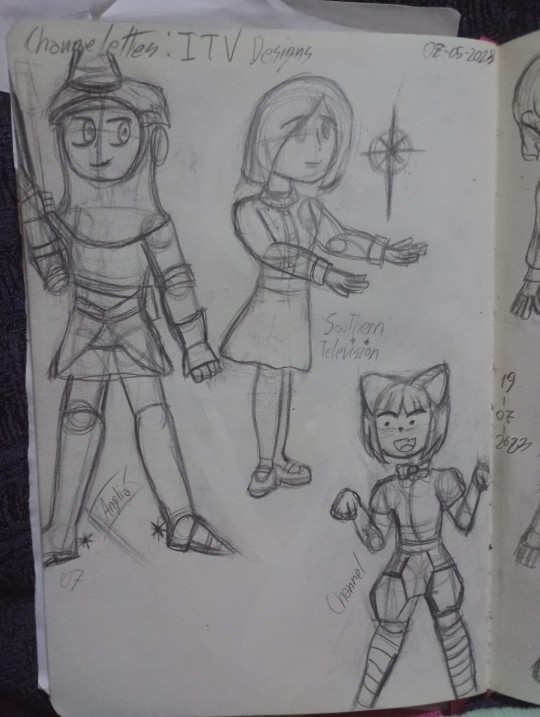
Featuring early designs of ITV's Anglia, Southern Television and Channel Television. All being part of the United Kingdom's ITV Network.
While I did some ideas of TV Gijinka before, Adam Martyn's Ident Review Extra episode of the ITV Idents inspired the whole new Channelette Project, and with it, those first three designs.
The design for Anglia convinces me, while the others need more refining. Especially Southern Television. Although, Channel Television will be a catgirl, without doubt.
Deutsche Welle (Or DW-Lette)

Made in May.
Sorry for the weird pose, I tend to do those. I don't know what's missing on DW-Lette's design.
RT-Lette
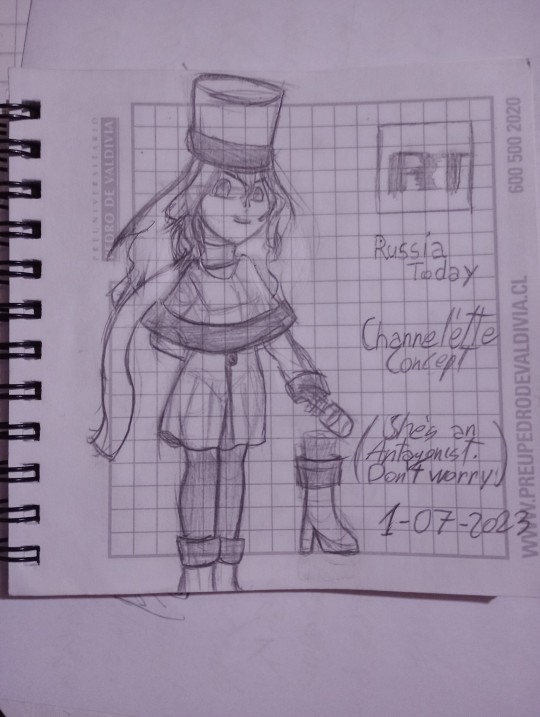
Based on the State-Owned Russian channel.
(Before I did this drawing, I did some sketch with her and CGTN. But I'll not post it here, since it's kinda unintelligible)
She will be portraited as a selfish daddy's girl (The "daddy" being of course The Pudin, You-know-who) who uses the majority of the money given for her own benefict. She doesn't like the other Channelettes. And the other Channelettes doesn't trust her.
She's CLEARLY made for satire. (NO Russophobia allowed with the character!! Xenophobia will NOT be tolerated!)
TV3 Catalunya
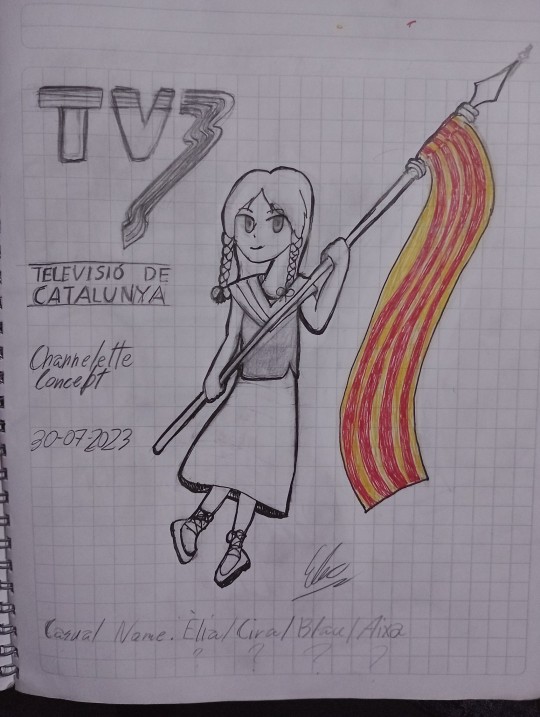
Based on TV3 of Catalunya, Spain.
The reason of me making this Channelette is because the 80s TV3 theme is so DAMN EPIC SOUNDING!!
I imagined a Gacha-Inspired animation of TV3-Lette with her flag-carrying spear. It was so cool, I HAD to draw her design.
I tried to draw her with a traditional Catalunya outfits. Making the flag was REALLY hard, though...
EARLY, PRE-CHANNELETTES IDEAS
(Note that NOT every design will be there. Because I sketched in different notebooks and I ended up missing some sketches)
1984 TVN Gijinka (or 1984 TVN-Lette?)
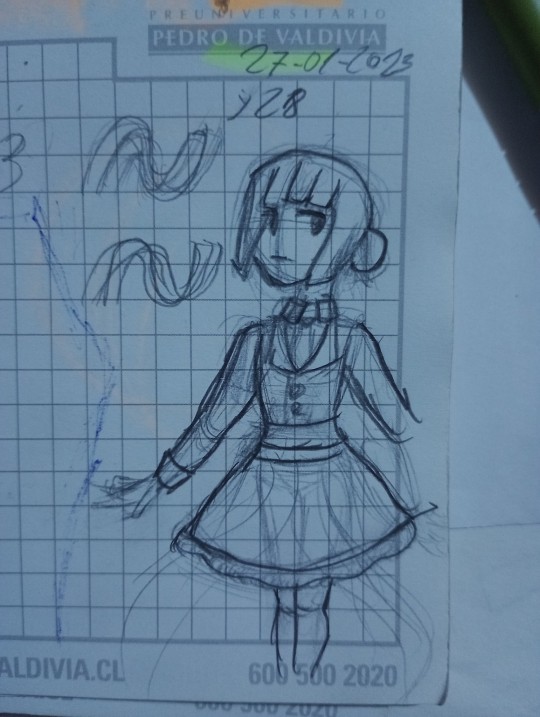
Done in January 2023. Based on Chile's TVN logo from 1984 until 1988.
I LOVE this TVN logo, even if it was short-lived. I love it due to how beautiful and creative the idents are, with those two ribbons moving around. Really elegant idents, also.
I tried to make her design look so formal (Authoritarian? because ya know, dictatorship)
She needs a more defined design and a bigger drawing. Random idea, she will have Ribbons on her main design.
BBC News Early Design
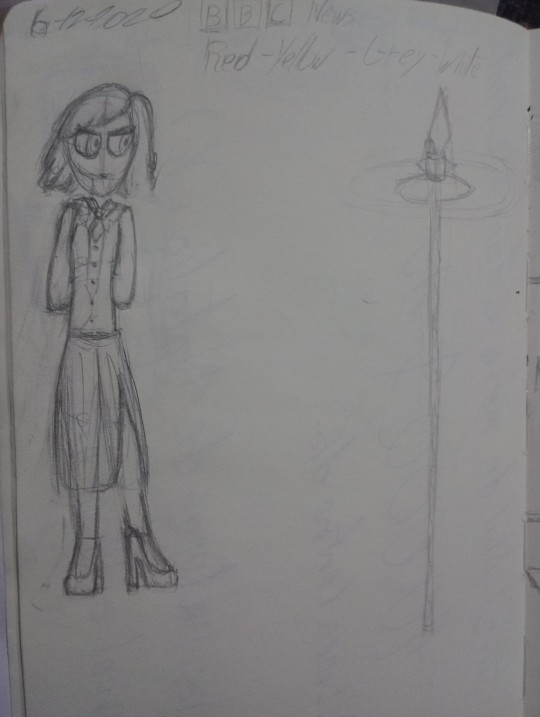
Okay. I forgot that this sketch was from 2020!
I Watched the BBC World News channel and sometimes I watch it with my dad's TV box. And I liked watching the idents and the intros. And I love the countdown.
And I tried to draw her more, but I stopped with this. She needs a better design, still. BUT the idea of her using a antenna-inspired spear as her main weapon will carry on her design.
UCTV Early Design

Based on UCTV, actually named Canal 13, from Chile.
Oh god (ironic), this design also comes from 2020! The idea was older than I thought.
His design was based on a priest, because the UCTV at that time was owned by a Catholic university from Chile. (WAS, nowadays no more, since... Late 2000s early 2010s)
Also because the channel used to show off some priests telling reflections before the channel signs off. (I remember catching some of those Reflections when I was a kid. But I didn't payed attention to those)
While I like this design, I think I'll redesign him. Spoiler of the new design idea, the channel used to have bumpers with angel cartoons, and it's why UCTV was nicknamed "The Channel of the Little Angel" ("El Canal del Angelito"). Wink Wink.

There was this 2022 redraw of UCTV-Lette's design, with another designs for two other Chilean channels.
UCV Televisión, which design is the one with heels and one-eye covering hair. She's was the oldest Chilean TV channel, so i'll try to give her justice on a upcoming design.
AND Telecanal. Which is the one who's holding a box exclaiming "Buy My Shit". The joke refers to the fact that Telecanal's programming consists of an ABSURD majority of infomercials, and little to NO original content... I'm still baffled that this channel SOMEHOW is STILL AIRING. Sorry for the random rant. I'll try to come up with a better design.
I'll be continuing posting more sketches, as well as develop more of the Channelette project.
I'll be making a Masterpost of the whole Channelette later.
When I return to digital drawing, I'll try to digitise the designs. (And Hopefully do more drawings in general. I'm trying to make drawings from my tablet but... I need to build confidence with it)
Hope you like it!
_Elec
#channelettes#sketches#sketch#character design#gijinka#anthropomorphic#TV channels#A cute queue#elecalice work
1 note
·
View note
Text
UCTV: How To Manage Obesity
View On WordPress
0 notes
Text
I grew up with OCW and UCTV (rip) and google techtalks (rip, the thing with the same name is unrelated). they're the reason I got interested in machine learning in high school in the 2000s
anyway last thing about university discourse: colleges don't gatekeep knowledge, they gatekeep certifications of knowledge.
the reference books are generally available; even if they're unreasonably expensive, they're still going to cost vastly less than college. you can also look at stuff like MIT OCW, where they publish the material for a lot of their courses online. you won't get your homework graded and questions answered, sure, but it's not like college professors have a monopoly on knowledge. you'll probably have problems finding someone willing to evaluate all your homework but that's not gatekeeping any more than the fact that artists generally don't take requests from random people is.
on the other hand, there is no way for you to get a college diploma without going to an accredited college and doing what they say. diplomas from non-certified colleges are generally not worth much.
to compare to the medical system: they don't gatekeep the knowledge that you have some condition, but they do gatekeep the Official Acknowledgement. some things require the official acknowledgement (prescription-only drugs, insurance coverage), some things don't (OTC medication, other kinds of treatment).
of course there are some conditions that are difficult to diagnose without specialist training, but there are many that aren't. and there are some kinds of knowledge that are difficult to learn without specialist instruction, but there are many that aren't.
9 notes
·
View notes
Photo

UCtv
#el.nakamori#El Nakamori#CHILE#Canal 13#UCTV#Logo#Fin de Transmisiones#Corporación de Televisión de la Universidad Católica de Chile
3 notes
·
View notes
Text
War Is A Force That Gives Us Meaning With Chris Hedges
War Is A Force That Gives Us Meaning With Chris Hedges
War Is A Force That Gives Us Meaning With Chris Hedges What Is It? The YouTube video War Is A Force That Gives Us Meaning With Chris Hedges by the YouTube channel University of California Television (UCTV). Here is the description for this video: Veteran New York Times correspondent Chris Hedges has covered conflicts in Bosnia, El Salvador and Israel. Tune in for this thought-provoking…

View On WordPress
#Chris Hedges#Empire#Imperialism#Military#Speech#The United States Of America#UCTV#United States#University of California Television (UCTV)#US Military#USA#Video#War#War Is A Force That Gives Us Meaning With Chris Hedges
1 note
·
View note
Video
youtube
Normally I give a quirky short bio, but the Youtube bio says it pretty well. “David Payne stars in this one-man play recalling the life and times of C.S. Lewis. Presented as part of the "Let There Be Light Series". Series: "Let There Be Light" [3/2003] [Humanities] [Show ID: 7183]; C.S. Lewis: My Life's Journey��. It is an entertaining, educational, and comedic 1 hour performance :)
Brief warning: there may be some mild language and a short mention of abuse. Other than that, it is amazingly well done; Enjoy!
5 notes
·
View notes
Text

Watch Randall Franks Appalachian Sounds tonight at 7 p.m. EST, his new TV show, on UCTV at Comcast 265, Charter 198 and Dalton Utilities Optilink 133 in Catoosa, Walker, Dalton and Chattanooga areas. Streaming live at https://uctvlive.com/streaming.html Tonight's guest will be Share America Foundation, Inc. Pearl and Floyd Franks Scholar banjo player Dawson Wright. Tune in for great music and talk. www..RandallFranks.com/store
0 notes
Link
More on Bernie Taylor’s work can be found on his web page www.beforeorion.com and in his book Before Orion: Finding the Face of the Hero.
#uc san diego#university of california#UCTV#bernie taylor#before orion#cosmology#cosmos#astronomy#astronomia#astro#stars#constellations#night sky#dark night sky#astro photos#astrophotography#myth#ancient#history#psychology#literature#joseph campbell#carl jung#Albert Einstein
0 notes
Text

2 notes
·
View notes